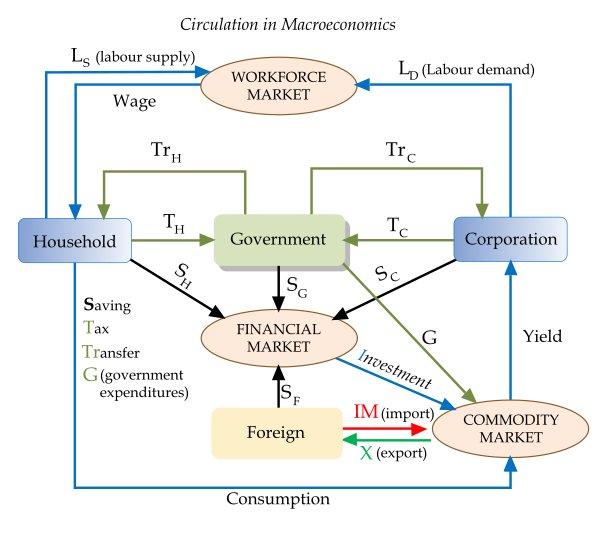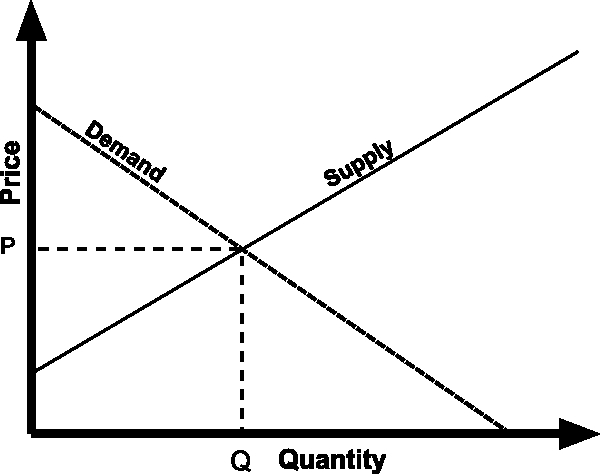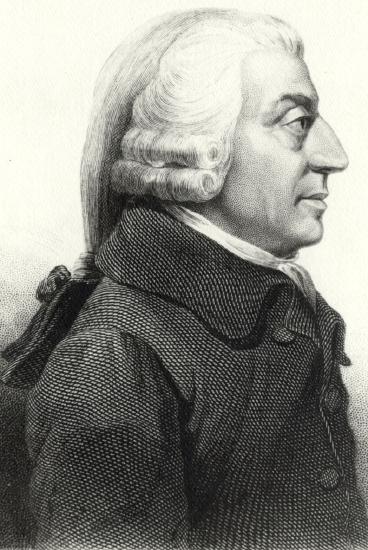Macroeconomics
Macroeconomics is the study of the performance, structure, behavior and decision-making of an economy as a whole.
Learning objectives
Define macroeconomics and identify the main users of macroeconomics
Macroeconomics is the study of the performance, structure, behavior and decision-making of an economy as a whole. Macroeconomists focus on the national, regional, and global scales. For most macroeconomists, the purpose of this discipline is to maximize national income and provide national economic growth. Economists hope that this growth translates to increased utility and an improved standard of living for the economy’s participants. While there are variations between the objectives of different national and international entities, most follow the ones detailed below:

Circulation in Macroeconomics: Macroeconomics studies the performance of national or global economies and the interaction of certain entities at the these level.
- Sustainability occurs when an economy achieves a rate of growth which allows an increase in living standards without undue structural and environmental difficulties.
- Full employment occurs when those who are able and willing to have a job can get one. Most economists believe that there will always be a certain amount of frictional, seasonal and structural unemployment (referred to as the natural rate of unemployment). As a result, full employment does not mean zero unemployment.
- Price stability occurs when prices remain largely stable and there is not rapid inflation or deflation. Price stability is not necessarily zero inflation; steady levels of low-to-moderate inflation is often regarded as ideal.
- External balance occurs when exports roughly equal imports over the long run.
- Equitable distribution of income and wealth among the economy’s participants. This does not, however, mean that income and wealth are the same for everyone.
- Increasing Productivity over time throughout the national economy.
To achieve these goals, macroeconomists develop models that explain the relationship between factors such as national income, output, consumption, unemployment, inflation, savings, investment and international trade. These models rely on aggregated economic indicators such as GDP, unemployment, and price indices.
On the national level, macroeconomists hope that their models help address two key areas of research:
- the causes and consequences of short-run fluctuations in national income, otherwise known as the business cycle, and
- what determines long-run economic growth.
Microeconomics
Microeconomics deals with the economic interactions of a specific person, a single entity or a company; it is the study of markets.
Learning objectives
Define Microeconomics, Identify the main users of microeconomics
Microeconomics deals with the economic interactions of a specific person, a single entity, or a company. These interactions, which mainly are buying and selling goods, occur in markets. Therefore, microeconomics is the study of markets. The two key elements of this economic science are the interaction between supply and demand and scarcity of goods.

Supply and Demand Graph: Microeconomics is based on the study of supply and demand at the personal and corporate level.
One of the major goals of microeconomics is to analyze the market and determine the price for goods and services that best allocates limited resources among the different alternative uses. This study is especially important for producers as they decide what to manufacture and the appropriate selling price. Microeconomics assumes businesses are rational and produce goods that maximizes their profit. If each firm takes the most profitable path, the principles of microeconomics state that the market’s limited resources will be allocated efficiently.
The science of microeconomics covers a variety of specialized areas of study including:
- Industrial Organization: the entry and exit of firms, innovation, and the role of trademarks.
- Labor Economics: wages, employment, and labor market dynamics.
- Financial Economics: topics such as optimal portfolios, the rate of return to capital, and corporate financial behavior.
- Public Economics: the design of government tax and expenditure policies.
- Political Economics: the role of political institutions in policy.
- Health Economics: the organization of health care system.
- Urban Economics: challenges faced by cities, such as sprawl, traffic congestion, and poverty.
- Law and Economics: applies economic principles to the selection and enforcement of legal regimes.
- Economic History: the history and evolution of the economy.
Key Differences
Microeconomics focuses on individual markets, while macroeconomics focuses on whole economies.
Learning objectives
Recognize questions addressed by microeconomics and macroeconomics
Stemming from Adam Smith’s seminal book, The Wealth of Nations, microeconomic and macroeconomics both focus on the allocation of scarce resources. Both disciplines study how the demand for certain resources interacts with the ability to supply that good to determine how to best distribute and allocate that resource among many consumers. Both disciplines are about maximization: microeconomics is about maximizing profit for firms, and surplus for consumers and producers, while macroeconomics is about maximizing national income and growth.

Adam Smith, Founding Father of Economics: Adam Smith’s book, Wealth of Nations, was the basis of both microeconomic and macroeconomic study.
The main difference between microeconomics and macroeconomics is scale. Microeconomics studies the behavior of individual households and firms in making decisions on the allocation of limited resources. Another way to phrase this is to say that microeconomics is the study of markets.
In contrast macroeconomics involves the sum total of economic activity, dealing with the issues such as growth, inflation, and unemployment. Macroeconomics is the study of economies on the national, regional or global scale.
This key difference alters how the two approach economic situations. Microeconomics does consider how macroeconomic forces impact the world, but it focuses on how those forces impact individual firms and industries. While macroeconomists study the economy as a whole, microeconomists are concerned with specific firms or industries.
Many economic events that are of great interest to both microeconomist and macroeconomists, though they differ in how they analyze those events. A shift in tax policy would interest economists in both disciplines. A microeconomist might focus on how the tax might shift supply in a specific market or influence a firm’s decision making, while the macroeconomist will consider whether the tax will translate into an improved standard of living for all of the economy’s participants.
Key Points
- For most macroeconomists, the purpose of this discipline is to maximize national income and provide national economic growth.
- The most common macroeconomic topics of study for national entities are sustainability, full employment, price stability, external balance, equitable distribution of income and wealth, and increasing productivity.
- Macroeconomists hope that their models help address two key areas of research: the causes and consequences of short-run fluctuations in national income (otherwise known as the business cycle) and what determines long-run economic growth.
- One of the major goals of microeconomics is to analyze the market and determine the price for goods and services that best allocates limited resources among the different alternative uses.
- Microeconomics assumes businesses are rational and produce goods that maximize their profit.
- The science of microeconomics covers a variety of specialized areas of study including: industrial organization, labor economics, financial economics, public economics, political economy, health economics, urban economics, law and economics, and economic history.
- Microeconomics and macroeconomics both focus on the allocation of scarce resources. Both disciplines study how the demand for certain resources interacts with the ability to supply that good to determine how to best distribute and allocate that resource among many consumers.
- Microeconomics studies the behavior of individual households and firms in making decisions on the allocation of limited resources. Another way to phrase this is to say that microeconomics is the study of markets.
- Macroeconomics is generally focused on countrywide or global economics. It studies involves the sum total of economic activity, dealing with the issues such as growth, inflation, and unemployment.
- There are some economic events that are of great interest to both microeconomists and macroeconomists, but they will differ in how and why they analyze the events.
Key Terms
- deflation: A decrease in the general price level, that is, in the nominal cost of goods and services.
- Macroeconomics: The study of the performance, structure, behavior, and decision-making of an economy as a whole, rather than individual markets.
- inflation: An increase in the general level of prices or in the cost of living.
- microeconomics: That field that deals with the small-scale activities such as that of the individual or company.
- Scarcity: an inadequate amount of something; a shortage
- inflation: An increase in the general level of prices or in the cost of living.
- microeconomics: The study of the behavior of individual households and firms in making decisions on the allocation of limited resources.
- Macroeconomics: The study of the performance, structure, behavior, and decision-making of an economy as a whole, rather than individual markets.
LICENSES AND ATTRIBUTIONS
CC LICENSED CONTENT, SPECIFIC ATTRIBUTION
- Macroeconomics. Provided by: Wikipedia. Located at: en.Wikipedia.org/wiki/Macroeconomics. License: CC BY-SA: Attribution-ShareAlike
- Macroeconomics/Macroeconomic Objectives. Provided by: Wikibooks. Located at: en.wikibooks.org/wiki/Macroec...mic_Objectives. License: CC BY-SA: Attribution-ShareAlike
- deflation. Provided by: Wiktionary. Located at: en.wiktionary.org/wiki/deflation. License: CC BY-SA: Attribution-ShareAlike
- Macroeconomics. Provided by: Wikipedia. Located at: en.Wikipedia.org/wiki/Macroeconomics. License: CC BY-SA: Attribution-ShareAlike
- inflation. Provided by: Wiktionary. Located at: en.wiktionary.org/wiki/inflation. License: CC BY-SA: Attribution-ShareAlike
- Circulation in macroeconomics. Provided by: Wikipedia. Located at: en.Wikipedia.org/wiki/File:Ci...oeconomics.svg. License: Public Domain: No Known Copyright
- Microeconomics/Definition. Provided by: Wikibooks. Located at: en.wikibooks.org/wiki/Microec...ics/Definition. License: CC BY-SA: Attribution-ShareAlike
- Microeconomics. Provided by: Wikipedia. Located at: en.Wikipedia.org/wiki/Microeconomics. License: CC BY-SA: Attribution-ShareAlike
- microeconomics. Provided by: Wiktionary. Located at: en.wiktionary.org/wiki/microeconomics. License: CC BY-SA: Attribution-ShareAlike
- Scarcity. Provided by: Wiktionary. Located at: en.wiktionary.org/wiki/Scarcity. License: CC BY-SA: Attribution-ShareAlike
- Circulation in macroeconomics. Provided by: Wikipedia. Located at: en.Wikipedia.org/wiki/File:Ci...oeconomics.svg. License: Public Domain: No Known Copyright
- Simple supply and demand. Provided by: Wikimedia. Located at: commons.wikimedia.org/wiki/Fi...and_demand.svg. License: CC BY-SA: Attribution-ShareAlike
- Microeconomics. Provided by: Wikipedia. Located at: en.Wikipedia.org/wiki/Microeconomics. License: CC BY-SA: Attribution-ShareAlike
- Macroeconomics/Macroeconomic Objectives. Provided by: Wikibooks. Located at: en.wikibooks.org/wiki/Macroec...mic_Objectives. License: CC BY-SA: Attribution-ShareAlike
- Microeconomics/Definition. Provided by: Wikibooks. Located at: en.wikibooks.org/wiki/Microec...ics/Definition. License: CC BY-SA: Attribution-ShareAlike
- microeconomics. Provided by: Wiktionary. Located at: en.wiktionary.org/wiki/microeconomics. License: CC BY-SA: Attribution-ShareAlike
- Macroeconomics. Provided by: Wikipedia. Located at: en.Wikipedia.org/wiki/Macroeconomics. License: CC BY-SA: Attribution-ShareAlike
- inflation. Provided by: Wiktionary. Located at: en.wiktionary.org/wiki/inflation. License: CC BY-SA: Attribution-ShareAlike
- Circulation in macroeconomics. Provided by: Wikipedia. Located at: en.Wikipedia.org/wiki/File:Ci...oeconomics.svg. License: Public Domain: No Known Copyright
- Simple supply and demand. Provided by: Wikimedia. Located at: commons.wikimedia.org/wiki/Fi...and_demand.svg. License: CC BY-SA: Attribution-ShareAlike
- AdamSmith. Provided by: Wikipedia. Located at: en.Wikipedia.org/wiki/File:AdamSmith.jpg. License: Public Domain: No Known Copyright





